12.2. Database correlations¶
A database correlation is a map that relates one or more different time-varying databases so that when accessed with a common time state, the database correlation can tell VisIt which time state to use for any of the databases in the database correlation. VisIt supports multiple logical time sliders, so time states can be changed independently for different time-varying databases in the same window. No time slider for any database can have any effect on another database. Sometimes when comparing two different, but related, time-varying databases, it is useful to make plots of both databases and see how they behave over time. Since changing time for each database independently would be tedious, VisIt provides database correlations to simplify visualizing multiple time-varying databases.
12.2.1. Database correlations and time sliders¶
When you open a database for the first time, VisIt creates a trivial database correlation for that single database and creates a new logical time slider for it. Each database correlation has its own logical time slider. Figure 12.4 shows a database correlation as the active time slider.

Fig. 12.4 Database correlation as the active time slider¶
Suppose you have plots from time-varying database A and database B in the same visualization window. You can use the logical time slider for database A to change database A’s time state and you can use the logical time slider for database B to change database B’s time state. If you want to change the time state for both databases at the same time using a single logical time slider, you can create a database correlation involving database A and database B and then change time states using the database correlation’s logical time slider. When you change time states using a database correlation’s time slider, the time state used in each plot is calculated by using the database correlation’s time slider’s time state to look up the plot’s expected time state in the database correlation. Thus changing time states using a database correlation also updates the logical time slider for each database involved in the database correlation.
12.2.2. Types of database correlations¶
A database correlation is a map that relates one or more databases. When there is more than one database involved in a database correlation, the time states from each database are related using a correlation method. Database correlations currently have 4 supported correlation methods: padded index, stretched index, time, and cycle. This section describes each of the correlation methods and when you might want to use each method.
For illustration purposes, the examples describing each correlation method use two databases, though database correlations can have any number of databases. The examples refer to the databases as: database A and database B. Both databases consist of a rectilinear grid with a material variable. The material variable is used to identify the database using a large letter A or B and also to visually indicate progress through the databases’ numbers of time states by sweeping out a red material like a clock in reverse. At the first time state, there is no red material but as time progresses, the read material increases and finally totally replaces the material that was blue. Database A has 10 time states and database B has 20 time states. The tables below list the cycles and times for each time state in each database so the time and cycle behavior of database A and database B will make more sense later when time database correlations and cycle database correlations are covered.
Time state |
0 |
1 |
2 |
3 |
4 |
5 |
6 |
7 |
8 |
9 |
Times |
14 |
14.5 |
15 |
15.5 |
16 |
16.5 |
17 |
17.5 |
18 |
18.5 |
Cycles |
0 |
1 |
2 |
3 |
4 |
5 |
6 |
7 |
8 |
9 |
Time state |
0 |
1 |
2 |
3 |
4 |
5 |
6 |
7 |
8 |
9 |
Times |
16 |
17 |
18 |
19 |
20 |
21 |
22 |
23 |
24 |
25 |
Cycles |
10 |
11 |
12 |
13 |
14 |
15 |
16 |
17 |
18 |
19 |
Time state |
10 |
11 |
12 |
13 |
14 |
15 |
16 |
17 |
18 |
19 |
Times |
26 |
27 |
28 |
29 |
30 |
31 |
32 |
33 |
34 |
35 |
Cycles |
20 |
21 |
22 |
23 |
24 |
25 |
26 |
27 |
28 |
29 |
12.2.2.1. Padded index database correlation¶
A padded index database correlation, like any other database correlation, involves multiple input databases where each database potentially has a different number of time states. A padded index database correlation has as many time states as the input database with the largest number of time states. All other input databases that have fewer time states than the longest database have their last time state repeated until they have the same number of time states as the input database with the largest number of time states. Using the example databases A and B, since B has 20 time states and A only has 10 time states, database A will have its last time state repeated 10 times to make up the difference in time states between A and B. Note how database A’s last time state is repeated in Figure 12.5.

Fig. 12.5 Padded index database correlation of A and B (every 5th time state)¶
12.2.2.2. Stretched index database correlation¶
A stretched index database correlation, like any other database correlation, involves multiple input databases where each database potentially has a different number of time states. Like a padded index database correlation, a stretched index database correlation also has as many time states as the input database with the largest number of time states. The difference between the two correlation methods is in how the input databases are mapped to a larger number of time states. The padded index database correlation method simply repeated the last frame of the input databases that needed more time states to be made even with the length of the database correlation. Stretched index database correlations on the other hand do not repeat only the last frame; they repeat frames throughout the middle time states until shorter input databases have the same number of time states as the database correlation. The effect of repeating time states throughout the middle is to evenly spread out the time states over a larger number of time states.
Stretched index database correlations are useful for comparing related related simulation databases where one simulation wrote out data at 2x, 3x, 4x, … the frequency of another simulation. Stretched index database correlations repeat the data for smaller databases, which makes it easier to compare the databases. Figure 12.6 shows example databases A and B related using a stretched index database correlation. Note how the plots for both databases, even though the databases contain a different number of time states, remain roughly in sync.

Fig. 12.6 Stretched index database correlation of A and B (every 5th time state)¶
12.2.2.3. Time database correlation¶
A time index database correlation, like any other database correlation, involves multiple input databases where each database potentially has a different number of time states. The number of time states in a time database correlation is not directly related to the number of time states in each input database. The number of time states in the database correlation are instead determined by counting the number of unique time values for every time state in every input database. The times from each input database are arranged on a number line and each unique time value is counted as one time state. Time values from different input databases that happen to have the same time value are counted as a single time state. Once the time values have been arranged on the number line and counted, VisIt calculates a list of time state indices for each database that identify the right time state to use for each database with respect to the time database correlation’s time state. The first time state for each database is always the first time state index stored for a database. The first time state is used until the time exceeds the first time on the number line, and so on.
Time database correlations are useful in many of the same situations as stretched index database correlations since they are both used to align different databases in time. Unlike a stretched index database correlation, the time database correlation does a better job of aligning unrelated databases in actual simulation time rather than just spreading out the time states until each input database has an equal number. Use a time database correlation when you are correlating two or more databases that were generated with different dump frequencies or databases that were generated by totally different simulation codes. Figure 12.7 shows the behavior of databases A and B when using a time database correlation.

Fig. 12.7 Time database correlation of A and B (every 5th time state)¶
12.2.2.4. Cycle database correlation¶
Cycle database correlations operate in exactly the same way as time database correlations except that they correlate using the cycles from each input database instead of using times. Figure 12.7 shows the behavior of databases A and B when using a cycle database correlation.

Fig. 12.8 Cycle database correlation of A and B (every 5th time state)¶
12.2.3. Managing database correlations¶
If you want to create a new database correlation or edit properties related to database correlations, you can use the Database Correlation Window. You can open the Database Correlation Window, shown in Figure 12.9, by clicking on the Database correlations option in the Main Window’s Controls menu. The Database Correlation Window contains the list of database correlations, along with controls that allow you to create new database correlations, edit existing database correlations, delete database correlations, or set global settings that tell VisIt when to automatically create database correlations.
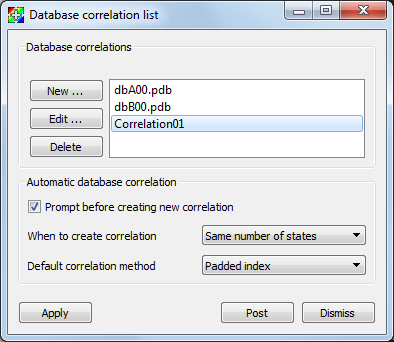
Fig. 12.9 Database Correlation Window¶
12.2.3.1. Creating a new database correlation¶
If you want to create a new database correlation to relate time-varying databases that you have opened, you can do so by opening the Database Correlation Window. The Database Correlation Window contains a list of trivial database correlations for the time-varying databases that you have opened. You can create a new, database correlation by clicking on the New button to the left of the list of database correlations. Clicking the New button opens a Database Correlation Properties Window (Figure 12.10) that you can use to edit properties for the database correlation.
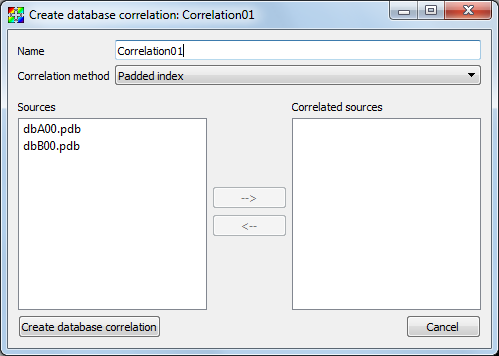
Fig. 12.10 Database Correlation Properties Window¶
New database correlations are automatically named when you first create them but you can change the name of the database correlation to something more memorable by entering a new name into the Name text field. Once you have entered a name, you should set the correlation method that the database correlation will use to relate the time states from all of the input databases. The available choices, shown in Figure 12.11, are: padded index, stretched index, time, and cycle.
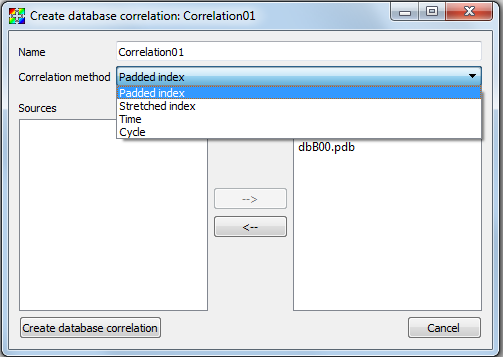
Fig. 12.11 Correlation methods¶
Once you have chosen a correlation method, it is time to choose the input databases for the correlation. The input databases, or sources as they are sometimes called in VisIt, are listed in the Sources list (see Figure 12.12). The Sources list only contains the databases that you have opened so far. If you do not see a database that you would like to have in the database correlation, you can either click the Cancel button to cancel creating the new database correlation or you can continue creating the database correlation and then add the other database to the correlation later after you have opened it. To add databases to the new database correlation, click on the them in the Sources list to highlight then and then click on the Right arrow button to move the highlighted databases into the database correlation’s Correlated sources list. If you want to remove a database from the Correlated sources list, highlight the database in the Correlated sources list and then click the Left arrow button to move it back to the Sources list. Once you are satisfied with the new database correlation, click the Create database correlation button to create a new database correlation.
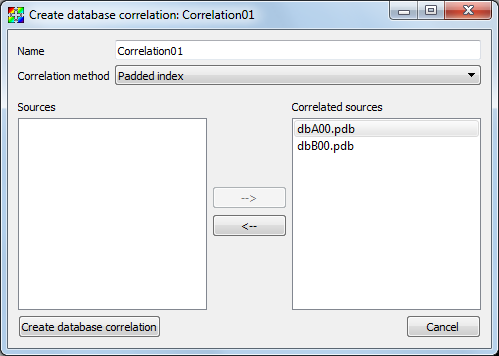
Fig. 12.12 Sources list and Correlated sources list¶
When you create a new database correlation, VisIt also creates a new time slider for the new database correlation. The database correlation’s active time state is initially set to the first time state, which might not match the time state of individual plots in the vis window. Once you change time states using the Time slider, the plots in the vis window will be updated using the correct time state with respect to the correlation’s active time state. As always, if you want to update the time state for only one database, you can select a different time slider using the Active time slider combo box and then change time states using the Time slider. Any time state changes made to an individual database that is also an input database for a database correlation has no effect on the database correlations that involve the changed database. Time state changes for a database correlation can only happen if you have selected the database correlation as your active time slider.
12.2.3.2. Altering an existing database correlation¶
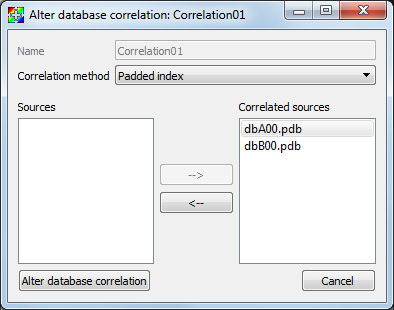
Fig. 12.13 Altering a database correlation¶
Once a database correlation has been created, you can alter it at any time by highlighting it in the Correlation list in the Database Correlation Window and clicking the Edit button to the left of the Correlation list. Clicking the Edit button opens the Database Correlation Properties Window and allows you to change the correlation method and the input databases. Once the desired changes are made, clicking the Alter database correlation button will make the specified database correlation use the new options and all plots in all vis windows that are subject to the changed database correlation will update to the new time states prescribed by the altered database correlation.
Using the Database Correlation Properties Window explicitly alters a database correlation. Reopening a file or refreshing the file list can implicitly alter a database correlation if after reopening the affected databases, there are different numbers of time states in the databases. When reopened databases that are input databases to database correlations have a new number of time states, VisIt recalculates the indices used to access the input databases via the time slider and updates any plots that were affected. In addition to the time state indices changing, the number of time states in the database correlation and its time slider can also change.
12.2.3.3. Deleting a database correlation¶
Database correlations are automatically deleted when you close a database that you are not using anymore provided that the closed database is not an input database to any database correlation except for that database’s trivial database correlation. You can delete non-trivial database correlations that you have created by highlighting a database correlation in the Correlation list in the Database Correlation Window and clicking the Delete button to the left of the Correlation list. When you delete a database correlation, the new active time slider will be set to the active database’s time slider if the active database has more than one time state. Otherwise, the new active time slider, if any, will be set to the time slider for the first source that has more than one time state.
12.2.3.4. Automatic database correlation¶
VisIt can automatically create database correlations when they are needed if you enable certain global settings to control the creation of database correlations. By default, VisIt will prompt you when it wants to create a database correlation. VisIt can automatically create a database correlation when you add a plot of a multiple time-varying database to a vis window that already contains a plot from a different time-varying database. VisIt first looks for the most suitable existing database correlation and if the one it picks must be modified to accommodate a new input database or if an entirely new database correlation must be created, VisIt will prompt you using a Correlation question dialog (Figure 12.14). If you prevent VisIt from creating a database correlation or altering the most suitable correlation, you will no longer be prompted to create a database correlation for the list of databases listed in the Correlation question dialog.
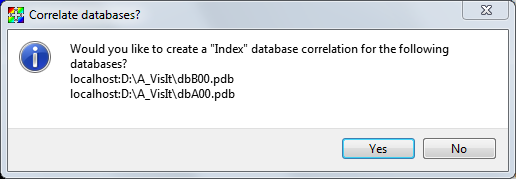
Fig. 12.14 Correlation question dialog¶
By default, VisIt will only attempt to create a database correlation for you if the new plot’s database has the same number of time states as the existing plot. You can change when VisIt creates a database correlation for you by selecting a different option from the When to create correlation combo box in the Database Correlation Window. The available options are: Always, Never, and Same number of states. You can change the default correlation method by selecting a new option from the Default correlation method combo box. Finally, you can prevent VisIt from prompting you when it needs to create a database correlation if you turn off the Prompt before creating new correlation check box.